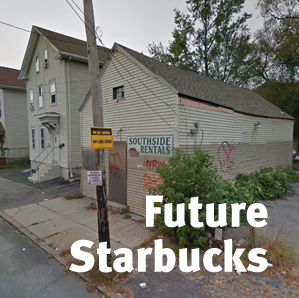
In the introductory post of this series on housing in the Providence metro, I laid out some basic concepts in antithetical pairs. I sought to show how policy advocates and community activists argue their competing viewpoints within a zero-sum logic, usually to the detriment of both. This post examines the process of radical neighborhood change commonly called gentrification. Like so much in life, it’s a good thing right up until it goes horribly wrong.
I gentrify
I sometimes describe myself—tongue in cheek—as a ‘serial gentrifier.’ For nearly 3o years, I have spent some amount of my time renovating buildings in San Francisco, Burlington, VT and greater Providence.
I have moved from city to city and neighborhood to neighborhood, always in the first wave of change in communities that would later be described as ‘gentrified.’ By they were considered gentrified, I was long gone, tearing out crumbling plaster in a neighborhood where few people would choose to live.
I have seen this process occur repeatedly, and I understand the basic mechanics. I also know that gentrification is not necessarily the inevitable result of a change to a more affluent demographic. Given certain rare conditions, this process can improve quality of life for most existing residents.
I have seen this happen in exactly one place: Mt. Hope in Providence. This neighborhood is largely gentrification-proof, and community-oriented urbanists would do well to study why.
How gentrification starts
For a neighborhood to become gentrified, two types of properties must be present is significant quantities: vacant properties and absentee-landlord properties. Those in the know may already predict that owner-occupation, regardless of socio-economic conditions, is the key factor that prevents gentrification.
Here’s how it works. Some young person—probably white, probably non-traditional, probably an artist, probably leftwing, probably already connected to low-income and/or minority communities—decides to get out of the losing game of paying rent on some crappy apartment. The one thing we know for certain about this person is that he or she is skilled in multiple construction trades, probably from some years working in the industry. If he or she is not, that’s about to change real fast.
This person has scraped together some pittance of a down payment, but can’t qualify for a mortgage, so he or she scours the very bottom of the real estate market—burn-outs, abandonments, tax foreclosures, bank-owned properties. Perhaps someone they know tips them off to a building on their block that can be bought for next to or for actually nothing. This building is probably legally uninhabitable, but this doesn’t stop our young person. In they move, and the rehabilitation begins.
This person’s friends start coming over to their house, and pretty soon one of those friends—slightly less non-traditional, slightly less leftwing, slightly-less connected to the community—buys a slightly less bombed-out piece of crap.
As this process continues, several things are happening. First, the number of abandoned properties starts to decline. Second, the condition of the worst property starts to improve. Third, the demographics of the buyer trend ever wealthier and more conservative. Lastly and most importantly, the price paid for the building starts to increase.
Conditions for local residents
To this point, local residents generally see these changes as positive. More people and fewer vacant houses generally improves safety and quality of life. Streets start looking nicer and on rare occasion an absentee landlord decides to put a little effort into improving a rental property. “Finally,” locals often remark, “it looks like somebody cares about this place.”
The only time I’ve seen this go otherwise was in a neighborhood in San Francisco now called Hayes Valley. The aftereffects of the 1989 earthquake played an enormous role in this neighborhood, but in 1985 it was largely African-American, largely supported by public assistance and largely bombed out. Drug-addicted prostitutes plied their trade in the area under the elevated highway. Such was my neighborhood.
My first rehab was the apartment where I lived, in exchange for rent. Like four of the six units in the building, it had been a flop for junkies. (Crack cocaine was about a year away from exploding into the urban environment.) I had grown up in the suburbs of New York and never lived in the inner city. It was a learning experience in many, many ways.
The problem for local residents in this slowly changing neighborhood was not that new residents were white or that they were more wealthy. The problem is that many of them were gay men. AIDS that year was epidemic in San Francisco, and less informed people of all walks of life feared any gay man. But even without AIDS, some portion of this neighborhood expressed outright homophobia, sometimes in very ugly ways. “I’m moving to my cousin’s in Oakland,” was a common theme amongst this set.
Even though his grown son had left for Oakland, my 70+ year old upstairs neighbor wouldn’t. “I don’t care if they [redacted],” he once said of the next door building’s owners, passing me a joint. “Place looks nice.” (A WWII vet and retired civil servant, his apartment was barracks-neat. He painted it himself on a continuous basis, as he had ships in the US Navy. Fabulous human, he was.)
Where it all goes wrong
So far, our hypothetical neighborhood has seen its abandoned properties get renovated and its demographics trend wealthier and whiter, but without negative impacts on the existing residents. That’s about to change. And once this part of the process begins, it won’t end until the neighborhood is completely transformed and virtually all of the original residents are displaced.
At some point, there are no more abandonments left, no more burnouts. Around the same time, the demographic mix reaches a tipping point where very white, very traditional, relatively wealthy and relatively conservative people see the neighborhood as a desirable place to live. Young couples clear the way for families with young children, and this is commonly the point at which true gentrification occurs.
Realtors likely did not participate in the first few sales. These tend to be owner-financed or bank purchases (REO/OREO) or facilitated by a government or non-profit. But eventually realtors become participants. Perhaps a young, ambitious realtor buys an abandonment and pays a crew for the rehab. (This is another data point indicating that bad things are about to happen—owners stop doing the work themselves and instead pay professional crews.)
Many realtor are also property investors, aka, absentee landlords. So before too long, absentee landlords recognize that selling their buildings could yield substantial cash profits. So realtors connect our mid-wave buyers (let’s call them) with absentee landlords, and the real problems start.
Most places have very weak tenants rights laws, and a change of ownership generally voids the lease. But most long-term tenants don’t have a lease because landlord-centric laws default expired leases to “month-to-month” agreements, meaning that either party can terminate the contract with 30-days notice. Lobbyists typically sell these laws as empowering tenants to get away from bad landlords, but the opposite is closer to the truth.
Eviction and homelessness
Gentrification’s endgame plays out with a distinctly ugly character. Longtime residents who had always paid their rent on time are turned out into the street with eviction notices. Or perhaps the new owner raises rents to force an eviction. (This past month, this occurred to one of the young people I mentor at an afterschool program. He and his family are now homeless, forcing him to drop out of the program and his GED courses. Yay, capitalism!)
It really doesn’t matter which way it happens, and the new owners rarely care one bit about what happens to these people. “They should get better jobs if they want to live somewhere nice,” is a typical sentiment.
We see this dynamic today in places like San Francisco or Harlem and Brooklyn in New York City. This wave has largely swept past the West Side in Providence and is headed toward Olneyville as I write.
Fight gentrification before it happens
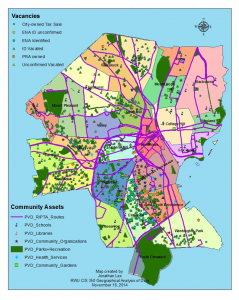
The only way to prevent gentrification from occurring is to prevent its prerequisite conditions from occurring. In plain language, community organizations should focus as much energy as possible into transferring abandonments to local residents.
The map at right was put together by local activist and RI Future reader Jonathan Lax. He is also a former title examiner and worked many, many transactions during the housing bubble. He is currently studying a cluster of interrelated issues in the Providence real estate market, including vacancies. This map shows Providence properties in some state of vacancy, foreclosure or abandonment.
Except this: he’s only got about 60% of the data fully parsed and added to the database. 40% of the abandonments in Providence are not in this map. The completed map will be about 2/3 denser. But already it shows pretty clearly the neighborhoods most susceptible to gentrification.
In 1997, I bought my first building; it was in Providence in the grey area between the Mt. Hope and Summit neighborhoods. Despite an influx of upscale whites, this neighborhood remains highly diverse because a very large percentage of the buildings were already owner-occupied. On the block where I bought this three-family, three of the six houses were owned by one extended African-American family. The building I bought was the only absentee landlord building in the four-block area. But then I moved in with my young family, and their were no absentee landlords at all.
People I know on Camp Street tell me that back in the 1970s and 80s, when the neighborhood and the rest of the city were at a low point, the Stop Wasting Abandoned Properties (SWAP) program in that area specifically targeted young, local renters to take over these properties. Today, these no-longer-young owners are passing on their properties to their grown children. Better yet, they are using the equity in their homes to help their children purchase contiguous or nearby properties.
Returning to the map, I hope that the CDCs and other community groups in Olneyville, Elmwood and the lower West Side can act aggressively to get these properties into local hands. [I have no data to support this, but my gut tells me that Silver Lake likely has a higher than average rate of owner-occupiers that survived the bubble. It’s a dense cluster, but I rank it well below Olneyville/Manton, which I think is Providence’s most gentrifiable neighborhood.]
Low-income communities and communities of color rightly fear the encroachment of affluent, white buyers; in almost all cases, it will lead to their eventual displacement. Rather than mount a futile campaign to stop the worst aspects once they start, people should recognize that every abandoned property is an opportunity to keep their community together.
But they have to buy-in to the process. Literally.
]]> Housing is among the key requirements for human survival. And it is arguably the single greatest defining factor for a community. The urban landscape, particularly in the US, has seen any number of experiments and approaches. Many have been abysmal failures.
Housing is among the key requirements for human survival. And it is arguably the single greatest defining factor for a community. The urban landscape, particularly in the US, has seen any number of experiments and approaches. Many have been abysmal failures.
Today, the “new urbanism” approach seeks to improve cities through a set of measures to increase density and decrease dependence on automobiles. To my mind, this all seems like a reversion to a 19th century approach, and that ain’t a bad thing. But it’s critical that future development not repeat the disastrous environmental impacts of a century ago.
This essay serves as the introduction to an ongoing discussion of housing policy in the greater Providence metropolitan area. It will layout some basic ideas in the form of polarities/conflicts/antitheses that future posts will build on.
I have some experience in this area, having reheated many a childhood dinner while my mother was at “the zoning board of peels.” (She later ran the Connecticut office of the Regional Plan Association.) I have occasionally been active in the local real estate market and have been a landlord for most of the past 17 years. And I have been a consultant around various urban planning and economic development projects. So perhaps I know a thing.
Markets versus policies
The single most challenging factor for housing policy advocates is that policies can only have a limited impact on the actual situation. Policies seek to shape the market, but the market generally finds a way to do what it wants. And when market-constraining policies are crafted as specific prohibitions or regulations, the real estate sector wields all the power it can muster to kill them before they become law. Which is not to say that the market should not be constrained or that housing policy should not be codified as law; it’s just a high mountain to climb.
The real estate market also brings an unflinching heartlessness to a life-critical area that, when it all goes wrong, can have devastating effects on individuals and communities. Homelessness in the US is largely driven by market forces that seek profit above all else. Those least able to absorb the shock of dislocation are the ones most vulnerable to it.
But we can also trace some of these dislocations to well-intentioned policies that have unintended consequences. Policies envisioned as helping a certain segment of the population—less advantaged, for example—usually end up helping the most advantaged and profit-hungry as well. It’s great to encourage owner occupation and neighborhood renewal; it’s bad when that becomes gentrification with its accompanying evictions.
So policy-makers and advocates would do well to act cautiously. The free market is a dangerous animal known for biting the hand that feeds it.
Houses versus communities
My biggest gripe with housing policy advocates is that they seem to lose sight of the fact that housing is the building block of communities. And the community, not the houses, should be the focus of the policy. Housing policy should not be about achieving some abstract aim like “density” or “walkability.” It should be about creating communities that work for the people that live there. High-functioning communities might have a high density or have services within walking distance of most housing, but these factors alone do not produce high-functioning communities.
Everything has trade-offs. Like in engineering, there is no perfect formula; there is only the best mix of compromises for a particular place at a particular time.
For example, in their zeal for density, urbanist can romanticize the effect that mass housing and corporate ownership will have on a community. Sure, that apartment complex looks great when it’s new; so did the ones that we now would classify as “blight.” Do corporate owners show the same care as owner-occupiers? As we’ve come to say in the House of Fry, “It’s not the machine; it’s the maintenance.”
Likewise, a dense, urban approach has environmental benefits in terms of fossil fuels and greenhouse gases, but it also has negative impacts in water use, waste water treatment demands, green space and stormwater runoff. Not for nothin’, but there’s a giant tunnel under Providence to store everybody’s poops during rainstorms, and that thing wasn’t free or without environmental consequence.
The point here is that the best approaches, the best communities, carefully balance the complex and conflicting issues in a way creates an organic response to the real-world situation at hand.
Building versus the built
One last conflict (for this essay, anyway) is that most housing policy only affects new construction. In other places or other times, this could have a major impact, but in a place like Providence, it can’t. There’s just too much stuff already built.
Any new policies need to accept the fact that most of this city already has an established mode: closely set, detached one-, two- and three-family structures. Bringing in other modes will necessarily change the quality of any given community. Again, this is not necessarily “bad,” but it is a factor that planners, policy makers and advocates need to consider.
Another aspect of this conflict is in how we look at design, architecture and historic preservation. How does a modern design impact a community of 19th century structures? Conversely, how far should we go in forcing owners to maintain historic architecture?
Those advocating in-fill development will find precious little open land in most of the city. There is some, certainly, on the South Side or out Manton Ave, but the vast majority of this town is already occupied. Perhaps that is why anything new or different creates such a ruckus. (Not that I’m specifically referring to the corner of Blackstone Blvd and Rochambeau…)
What lies ahead
How weird is it that the RI Future author most closely associated with the phrase “polemic, left-wing screed” is the one arguing for balance and moderation in this discussion? The irony certainly is not lost on a person who routinely refers to himself in writing in the third person!
I might know a thing, but I don’t know everything. And neither do you. Amongst us all, though, we probably have most of this covered. What’s not mentioned above, but will rear its ugly head soon enough, is how income or the lack thereof affects both the market and the policies that we craft. Like…real soon.
Next installment: The mechanics of gentrification
]]>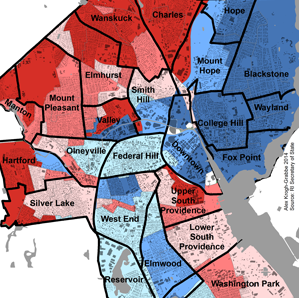 In the 2014 Providence mayoral election, municipal unions broke unanimously for Buddy Cianci, as did the Teamsters and others. When a huge margin from the East Side put Jorge Elorza over the top, Cianci’s union supporters immediately called it “class warfare,” saying there were two Providences—the East Side and everywhere else.
In the 2014 Providence mayoral election, municipal unions broke unanimously for Buddy Cianci, as did the Teamsters and others. When a huge margin from the East Side put Jorge Elorza over the top, Cianci’s union supporters immediately called it “class warfare,” saying there were two Providences—the East Side and everywhere else.
The data don’t support this assertion in general or in the particulars. It would be more accurate to say that the two Providences are the northern and western suburban precincts and everywhere else. But even this is too broad truly to capture the results. Like most things in life, it’s complicated.
Who won what by how much?
Alex Krogh-Grabbe, who was an Elorza operative and ran his website, produced this map of precinct level data drawn from the Board of Elections website. This map is different from other maps you might have seen because Mr. Krogh-Grabbe went to the extraordinary effort to hand collate precinct data, which is the only way to render these data into a manipulable format.
(This means he went precinct by precinct, hand copying the results into a spreadsheet or JSON file, then mapping that to precinct boundaries. The heavy lines are not the city’s wards but some sort of neighborhood breakdown. Great will be the day that all these data—precinct results, precinct boundaries, ward boundaries, etc.—are available from the city and state in open data standards. Until then…)
This map shows that there are many cities, or more aptly put, one complicated city. Cianci won most strongly in the most northern and western suburbs; Elorza won most strongly east of the Moshassuck River. In between, there is an interesting and complicated patchwork of support, with more of the city breaking for Elorza than for Cianci.
Look, for example, at the Valley. Two precincts that don’t just abut but seem to over-cross each other, broke more than 20% for each candidate. Likewise, the Jewelry district and Hospital district abut, but broke strongly in opposite directions.
Cianci clearly has support on the South Side, but Elorza countered in Elmwood, the West End and Reservoir. In a shock to many, Elroza took Federal Hill by a narrow margin.
Class warfare? Not so much.
Those crying “class warfare” need to step back and consider that Providence might be more complicated than they’d like it to be. Consider, for example, that Fox Point broke for Elorza by more than 20 percentage points or that Mt. Hope did the same by more than 10. Olneyville, Reservoir, deep in the West End and the brutal section of Smith Hill between Smith and Orms (my first PVD ‘hood) broke for Elorza. Elorza also won portions of Hartford and Silver Lake. Not one of these neighborhoods fits the profile convenient to the argument that only rich, white people support Elorza.
It could be that the East Side / South Side coalition was a short-lived experiment that won’t be repeated. Or it could be that changing demographics and changing attitudes have produced a new electoral equation in the city. Or it could be that Buddy Cianci made a whole lot of people a whole lot of money during his multiple terms in office, and that money trumps pretty much everything.
Whatever happened in this election, I am certain of one thing: it wasn’t class warfare.
]]>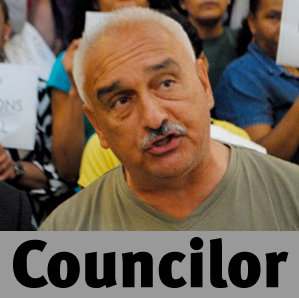 When RI Future first broke the story of Marcus Mitchell’s write-in campaign, the mainstream media wouldn’t give it so much as a mention. But on the Wednesday after the election, it was big, big news. Ahead by a mere 22 votes in the “machine count,” Mitchell would ultimately lose to the incumbent Kevin Jackson on the mail-in ballots.
When RI Future first broke the story of Marcus Mitchell’s write-in campaign, the mainstream media wouldn’t give it so much as a mention. But on the Wednesday after the election, it was big, big news. Ahead by a mere 22 votes in the “machine count,” Mitchell would ultimately lose to the incumbent Kevin Jackson on the mail-in ballots.
Regardless of anybody’s opinions of either candidate or their campaigns, we all should recognize that we have witnessed a near-historic exercise in the power of electoral participation. As I have written repeatedly, candidates running unopposed in the primary and/or general election are the hallmarks of a political machine, and political machines destroy communities.
Whether you like it or not, a large portion of Ward 3 made a powerful statement that they were dissatisfied with Jackson’s leadership and wanted a new voice. That portion of the ward proved just smaller than those who supported Jackson. And that’s how it goes in an electoral government.
The question now is: how will Jackson respond to the uprising against him?
Respond or retaliate?
There was a sense in the final week leading up to the election that the real winner in Ward 3 would be Ward 3. Suddenly faced with a serious challenge, Jackson remembered that there was a ward to be taken care of. Seemingly overnight, all the dangerous trip hazards that had lingered for many years on the commercial section of Hope Street were fixed.
But now that we’ve all recovered from the euphoria and/or depression and/or hangover, it has occurred to some in the Mitchell camp that rather than responding to their long-ignored issues, Jackson may chose to retaliate against those who opposed him. He was Cianci’s co-chair, the thinking goes, and we all know how Mr. Cianci dealt with such issues.
So far, I have heard nothing either way, nor was I out looking for it. This man does not live by politics alone. Were I one of Jackson’s advisers, my counsel would be to win over his detractors by acting on their behalf…you know, like an elected representative. Four years is time enough to heal the wounds and rebuild the coalition.
Conversely, those opposed to Jackson may well be wondering why they didn’t challenge him earlier. The conventional wisdom was that his stronghold would prove unbreakable. But if a last-minute, write-in candidate can take him to a hand count of the mail-in ballots, imagine what a proper campaign for the Democratic primary could achieve.
Jackson likely knows this as well. At a certain level, it doesn’t matter what he does over the next three-and-a-half years. If I were a gambling man, I would bet folding money that there will be a Jackson-Mitchell rematch in 2018 and this time for the Democratic primary.
Just like with the Mitchell write-in campaign, remember, readers: you heard it here first!
]]> It is possible that Marcus Mitchell will win the race for Providence City Council Ward 3 with a write-in campaign.
It is possible that Marcus Mitchell will win the race for Providence City Council Ward 3 with a write-in campaign.
If he does, it will be an historic achievement. Has Providence ever seen such an occurrence?
The preliminary count shows “write-in” with a 22-vote lead over incumbent Kevin Jackson, 1,829 to 1,807. Emergency ballots and mail-in ballots have not yet been counted, and the write-in ballots must be certified. Mickey Mouse and Donald Duck typically receive a few votes in nearly every political contest, and misspellings could also erode Mitchell’s count.
Many in Ward 3 feel that even if Jackson holds on to his seat, he will be a very different councilor. His support for Cianci put him on the wrong side of the electorate, and he must surely know that he will face a vigorous primary challenge in 2018. This race showed him a weak incumbent.
A tale of two turnouts
The single most striking take-away for me was the low turnout in precinct 2818 that includes most of the Camp Street neighborhood. Jackson won this precinct roughly 2:1, but with fewer than 600 votes cast. Compare this to the 2012 election when over 1,600 votes were cast in 2818.
Of course, 2012 was a presidential election and this was a midterm, and redistricting makes a comparison to 2010 impossible. But consider this: precinct 2816 at the north end of the ward cast nearly 1,300 votes compared to about 1,800 votes in 2012.
In other words, turnout in 2816 fell about 1/3 while turnout in 2818 fell by 2/3. The common wisdom said that Camp Street was Jackson’s base of power, but when challenged, he could not turn out the vote. Results from precinct 2880, which includes the northern end of Camp Street, showed tepid activity with fewer than 450 votes cast total.
If Jackson had turned out the vote in these precincts, he would have won handily.
What’s next?
Your Frymaster is in uncharted territory here. I need to find out how and where the ballots will be counted. As always, I’ll let you know what I find.
]]>Poll watchers, which Elorza had at each of the city’s 80 polling places, mark each voter’s name as poll workers call them out. They then look up the name on their anotated voter rolls, which also track that voters support level for the candidate. With modern data tools, poll watchers have become a critical part of election campaigns and they generally predict the outcome with great accuracy.
UPDATE 11/4, 7:30am — Preliminary numbers from the Board of Elections show 35,472 votes cast for mayor of Providence. Elorza received 3,375 more votes than Cianci, making his margin of victory 9.5 percentage points. Just sayin…
]]>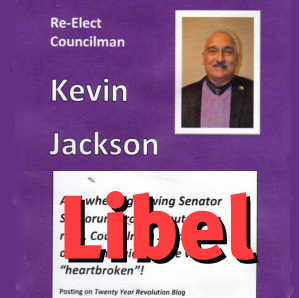 Providence Ward 3 City Councilor Kevin Jackson distributed flyers under his own name, repeating the false claim originally voiced by the Providence Apartment Association on his behalf, namely that his write-in challenger Marcus Mitchell lamented Rick Santorum’s withdrawal from the 2012 presidential race.
Providence Ward 3 City Councilor Kevin Jackson distributed flyers under his own name, repeating the false claim originally voiced by the Providence Apartment Association on his behalf, namely that his write-in challenger Marcus Mitchell lamented Rick Santorum’s withdrawal from the 2012 presidential race.
Meanwhile, the Mitchell campaign has sent Jackson a letter that provides clear, compelling exculpatory evidence and demands an immediate retraction. If Jackson and his campaign continue to distribute this flyer now knowing for certain that their claim is false, it becomes bona fide libel.
According to information from the Mitchell campaign, Jennifer Seitz, who teaches political science at Georgia Perimeter College created and managed the blog Twenty Year Revolution from which the quote was taken. This fits with similar results from my own searching for “jenecseitz,” the WordPress user that authored all the post on the blog. The Mitchell campaign has also located a person named Marcus Mitchell who attended Georgia Perimeter College.
Any slightly savvy Internet user would look at Twenty Year Revolution and realize that this was a teaching tool created specifically to engage students in using social media in a political context. If you scan a number of posts, you’ll see many of the same names over and over again. Also, 100% of the comments use the same format of posting a single link as an addendum.
Your Frymaster has reached out to Ms. Seitz about this situation and will update this post with any new information.
UPDATE: 11/3, 8:30 AM—Jennifer Seitz replied with the following:
[Twenty Year Revolution] was a teaching tool used in my American Government course at Georgia Perimeter College. Marcus was a student of mine, I do remember him, and I can assure you he is not running for office in Providence.
More on Marcus Mitchell:
- Jackson allies smear Marcus Mitchell – Frymaster
- Uprising in Ward 3: Marcus Mitchell wages write-in campaign – Frymaster
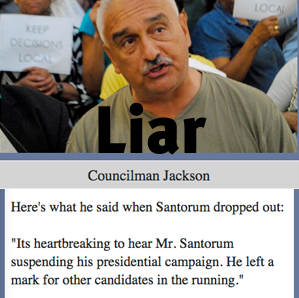 In 2010, Frank Caprio inexplicably destroyed his campaign by telling Barack Obama to “take his endorsement and, really, shove it.” Ward 3 city councillor Kevin Jackson may be having a similar moment. Jackson-backers the Providence Apartment Association sent out an email today potentially libeling Marcus Mitchell, attributing to the write-in candidate a quote that Jackson and the PAA can’t possibly believe was actually made by their opponent.
In 2010, Frank Caprio inexplicably destroyed his campaign by telling Barack Obama to “take his endorsement and, really, shove it.” Ward 3 city councillor Kevin Jackson may be having a similar moment. Jackson-backers the Providence Apartment Association sent out an email today potentially libeling Marcus Mitchell, attributing to the write-in candidate a quote that Jackson and the PAA can’t possibly believe was actually made by their opponent.
The quote by a person using the name Marcus Mitchell laments Rick Santorum dropping out of the 2012 presidential race. The email does not provide a source or context for the quote and asserts that it was Jackson’s opponent who made the statement. The PAA has to know that this is not true, and that would make it libel, a civil but not criminal offense.
But we can’t prove it. At least not yet.
Department of dirty tricks
The PAA is among the unsavory supporters swirling around the Jackson/Cianci camp. These are the investment property owners who, unsurprisingly, don’t like having to pay taxes. Jackson has promised to work to repeal the tax increase on non-owner-occupied rentals. In common parlance, this is an association of slumlords.
In their three+ years on Facebook, the PAA has garnered a whopping 132 “likes”. Not exactly a groundswell of support. And, honestly, do most people in Providence really care what these people think or want? Obviously, Mr. Jackson does.
Let’s not forget that Mr. Jackson already made the bad decision to co-chair Buddy Cianci’s 2014 mayor campaign. Nor should any of us be surprised that old-school influence peddlers like Jackson and Cianci would resort to such tactics. Jackson is savvy enough not to have done this himself, letting the already-disliked PAA take the fall for this foolish, borderline-criminal blunder.
The exact portion of the email in question reads:
As a registered republican in Philadelphia, Mr Mitchell also was a top level aide to Rick Santorum [true] and wanted him to be President. [not true]
Here’s what he said when Santorum dropped out:
“Its heartbreaking to hear Mr. Santorum suspending his presidential campaign. He left a mark for other candidates in the running.” [somebody, using the name Marcus Mitchell, said this]
Politicians resort to dirty tricks for one reason and one reason only: they’re scared. If Kevin Jackson were confident in his chances after last night’s candidates forum, this email would never have gone out. The incumbent can feel the momentum that Mitchell is generating. He certainly felt it last night when the Mitchell supporters seemed the more numerous and proved themselves the more enthusiastic by their applause. Cheers for Jackson’s closing remarks, in which he stumbled and repeated himself, were distinctly tepid.
Note to Kevin Jackson: there’s this thing called the Internet
20 years ago, it probably have taken Mr. Mitchell weeks to debunk this smear, if he could debunk it at all. But today, it will be over in a single news cycle. Because the Internet.
This whole Internet thing must be fairly new to people like Kevin Jackson. I mean…I can’t find a Facebook page for his campaign or a Twitter account or even a website. Hell, his page on the city council website doesn’t even have a photo!
Mr. Jackson and the PAA will probably be surprised at how fast this blows up in their faces.
Here’s the source of the quote. It’s from a comment from an otherwise anonymous blog commenter using the name Marcus Mitchell, and it comes at the bottom of a small post on an obscure, now defunct blog called Twenty Year Revolution. The second sentence in the comment reads:
I’m not into politics or elections.
That’s the give-away. At the time this comment was made (April 2012), Marcus Mitchell was up to his neck in the highly-politicized fight to create the Providence Community Library.
While there’s no smoking gun that would prove Jackson and PAA the knew that the quote was not from their opponent, they knew. If there were a smoking gun (or if one turns up), that would make it libel, and libel is punishable in civil court.
But here’s how you know that Jackson and the PAA knew these are different people: their email had already brought up their opponent’s highly political past. They knew this wasn’t him.
Mitchell’s Republican past
From Day One, the Jackson camp has tried to make hay out of the fact that their opponent—our Marcus Mitchell—was once a registered Republican and served as a staffer for then-US Senator Rick Santorum. Mitchell ran Santorum’s community relations circa 2005. This story from the alt-weekly Philadelphia City Paper about protesters wanting to contact both PA senators shows exactly how Mitchell handled the office—brilliantly.
Regarding this period of work, the Mitchell campaign has said:
As a longtime progressive, Marcus does not share Sen. Santorum’s views on social issues and the senator was aware of that when he offered Marcus the position as Director of Community & Economic Development. He was offered the job because of his record of community service in the Philadelphia area, and he took the job in order to assure that issues of diversity and reconciliation would be considered in the office of one of the country’s most conservative legislators. It was a courageous step to take and he is proud of the work he did there.
The choice in ward 3
Some may find Mr. Mitchell’s GOP past unsettling, even a deal-breaker. But 100% of the people I know who have worked with him in Providence have nothing but the best to say about him. And it is clear from the organizations he has chosen to lead that this is a man who puts community interests first.
Voters in ward 3 need to chose between this challenger—an open book with a proven history of building successful movements and coalitions—and a barely-visible incumbent allied with the worst actors on the political scene.
Not really a choice, is it?
]]>
The Providence city council seat for ward 3 appears to be suddenly in play. Economic development consultant and leadership author Marcus Mitchell is gathering support for a write-in campaign against previously unchallenged incumbent Kevin Jackson. And it looks like Mitchell can win.
Mitchell was the founding president of the Providence Community Library and has been a longtime Mt. Hope activist. This activism gives him significant traction in the all-important precinct 2818 that includes the Camp Street neighborhood. But even more importantly, he is married to Lynette Lopes, the daughter of former city councilor Danny Lopes. The Lopes clan enjoys significant influence on Camp Street and could play a pivotal role in winning votes for Mitchell.
Targeting a longtime foe
Kevin Jackson is not well-liked in much of ward 3 nor on the left in general. He is co-chair of Buddy Cianci’s 2014 mayoral campaign and boasts the ethics record to justify that position. He currently ranks #13 on the Board of Elections’ list of violators with more than $30,000 in unpaid fines for failure to file campaign finance reports.
Most on the left have long assumed that Jackson’s core of support in precinct 2818 would protect him from challenges from the hard-core liberal precincts farther up Hope Street. I live in one of these precincts, and I have actually said the words, “If I thought I could beat Kevin Jackson on Camp Street, I would run against him.”
Precinct 2818 put Gordon Fox over the top against challenger Mark Binder in 2012. Our takeaway was that this is The Machine’s stronghold, and that Jackson could marshall these forces just as Fox had.
We were wrong.
More bad news for Jackson
Marcus Mitchell is an experienced business and civic leader; he knows how to make things happen. And he knows how to decide whether it’s wise even to try to make something happen. Thus, he commissioned a professional poll to assess the situation; the results were a shock.
After 20 years on the city council, Kevin Jackson enjoys stunningly low support in ward 3. Mitchell’s poll asked, in essence “Does Kevin Jackson deserve to be reelected?” Only 16.9% said Jackson should be reelected versus 41.2% for electing someone new. 16.9% is not a large number. Even worse, on the initial question of Jackson vs. Mitchell (before message testing), Mitchell wins by a narrow margin. After message testing—the campaign violations and association with Cianci—it’s all over. Mitchell wins by 60 points. SIXTY!
Given that Jackson’s perceived stronghold on Camp Street will at best split 50/50 and that he is loathed in the other three precincts, Ward 3’s ability accurately to spell M-A-R-C-U-S M-I-T-C-H-E-L-L could decide whether Kevin Jackson is looking for a new job in 2015.
Here’s Mitchell in action after a victory for the Providence Community Library. It’s Game On in ward 3.
]]> Some readers may recall that yours truly advised Angel Taveras’s 2010 mayoral campaign on the issues of information technology, web services and open government (known then as “government 2.0”). Later, I served on the transition committee studying these same issues and served on the Open Providence Commission for Transparency and Accountability that met throughout 2012.
Some readers may recall that yours truly advised Angel Taveras’s 2010 mayoral campaign on the issues of information technology, web services and open government (known then as “government 2.0”). Later, I served on the transition committee studying these same issues and served on the Open Providence Commission for Transparency and Accountability that met throughout 2012.
The commission issued a report and recommendations in early 2013. And, much to my surprise, the Taveras administration actually tried to implement it. You could fill the library at Alexandria with the commission and consultant reports that were written and immediately shelved. (Commerce RI’s 2010 Roadmap to a Green Economy comes to mind…)
The push toward implementation shows that Taveras and his administration took these issues seriously, as they rightly should. It is a pity that he won’t be able to pick up on the good work done on this front by Governor Chafee at the state level, but I digress.
Open data and information technology are the kinds of tedious, nerdy things that nobody cares or thinks much about—much like highway bridges—until they break. Then everybody freaks the hell out. The fact is that open access to government data or the lack thereof has a profound effect on regular people.
Would you like to log in to your account with the city government and see all your stuff there on a single page? When I say “your stuff” I mean your car tax, your property tax, your parking tickets, your application for a vendors license, your building permits, your communications with public works about that dead tree that’s about to take down the utility lines, etc. Yeah, that stuff.
I certainly would, but I can’t. And it’s not like I haven’t tried. On the commission, my main job was constantly to advocate that the city provide basic web services for residents and develop an internal capability to do so instead of paying ridiculous money to third parties that provide mediocre, rapidly obsolete systems. Sensible and cost-effective as this might be, it remains just a distant possibility. Many things need to change—especially the knowledge and attitudes of city councilors, department heads and…well, everybody in government that can’t make a web page with a text document.
The ugly reality of IT in Providence city government
Your Frymaster also enjoyed a courtesy interview for the role of Chief Information Officer for the city, but I was never really in the race. Jim Silveria, who landed that job and also served on the commission, has done his best to deliver on the commission’s recommendations. This is no slight to Jim. It’s an indictment of the inertia, entrenched interests, lack of resources and lack of capability of existing resources within city government.
I would not have made the same decisions that Jim has, and that’s probably why he got the job instead of me. But at least he made decisions and moved the situation forward in a significant way.
Providence now has an open data portal, an open meetings portal, live streaming and archived video of council meetings and highly-transparent, browsable repository of all the bids to all the city’s RFPs since they started using the system earlier this year. Not for nothin’, but that’s serious progress.
Here’s the thing: all of those new services—just like the previously existing services for paying parking tickets, taxes and your water bill—are from third parties. Expansion of the city’s internal capabilities has been virtually nil. (NB: the RFP repository was developed in-house by the city of Newport, so it can be done—even in RI. Also, using Ustream and Vimeo for the video is kind of a no-brainer.)
While it’s true that outdated job descriptions and overall municipal employees union intransigence hold the city back, the primary cause is a catch-22 in which a lack of resources leads to inefficient use of the resources that are available. This problem stems from an overall lack of understanding at the highest levels (in this case, the city council, department heads and possibly even the executive administration) of the importance of investing in technology and tech-savvy people.
By no means is Providence alone in this regard. Most governments and most corporations have the same problem. This 2008 article by the internationally renowned IT pioneer JP Rangaswami sums it up pretty well. JP starts by repeating one of his favorite quotes, itself from years before:
When you turn down a request for funding an R&D [read: IT] project, you are right 90% of the time. That’s a far higher rate of decision accuracy than you get anywhere else, so you do it.
And that’s fine. Except for the 10% of the time you’re wrong. When you’re wrong, you lose the company.
~ Howard Schneiderman [editorial comment is mine]
If you go read that article, scroll down to the comments. Somebody you know might have weighed in…
“There’s two ways to do things: the right way and
the Army way”
My father used that well-trod quip anytime I tried to cut corners or get away with a half-assed effort. At its core is the recognition that institutions have a hard time changing their thinking and making the tough decision to do what’s best in the long run. Corporations have quarterly reports to shareholders; governments have elections. Doing today the same thing you did yesterday and kicking the can down the road remain the default options for almost every leader everywhere.
And more’s the pity.
In the case of the city of Providence, the combination of an inflexible union, a poorly informed city council, resistant department heads and the absence of a breakthrough leader that could change those three previous items has created the situation where you cannot do things the right way; you can only do things the Army way. Specifically, the city can’t hire a qualified IT person for $100,000 per year, but the city can pay an outsider vendor $100,000 a year to do what the qualified IT person could do in a couple of months.
Thus our tax dollars—that could be paying local people and small IT firms to do great work, as I have repeatedly advocated—go to massive, far off corporations that give us mediocre systems. Just imagine what the city pays in licensing fees just for Microsoft Office. Right?
Code Island, civic hackers and open data
In 2014, Code for America sent a cohort of fellows to work with the state of Rhode Island and created the first state-level “brigade,” Code Island. (All previous brigades worked at the municipal level.) Yours truly serves as the official brigade Storyteller, a CfA-required position for all brigades that roughly translates as communications resource. Open Providence commission chair John Marion and commissioner Nelson Rocha also play active roles. Shawn Selleck, the civic innovation consultant to the city of Providence who has helped Jim Silveria fight the good fight at City Hall, is the brigade’s official Community Organizer.
CfA and its brigades are known as “civic hackers,” computer systems developers and designers that volunteer their time and talent to produce web- and mobile-enabled software applications that let regular people see and use government data. Code Island is greatly enabled by Jim Silveria and Thom Guertin, a Woonsocket native and RI’s Chief Digital Officer.
Code Island has several development projects in process, the most ambitious being a visualization tool that will let users slice and dice the five years of state budget data recently released on the state’s transparency portal. Our tool will provide far greater detail and flexibility that the state’s visualization. Again, this is no slight to RI.gov or Thom and his team. They can only do so much, and by making the data accessible to us, they enable us to take it to the next level.
This is how civic hacking works: open data + free apps = teh awesome.
Code Island wants the candidates on the record
Last week, the brigade sent the three major candidates for mayor of Providence a questionnaire, asking them to go on the record about how they would approach the issue of open data. We focused only on the city of Providence because, despite the significant progress that the Taveras administration has made, we still rate just a D+ for spending transparency, according to RIPIRG.
It’s not like RIPIRG has an ax to grind on this. The rating is in line with the open data census that the Open Knowledge Foundation runs. We rank #41 with a score of 230 compared with New York City, the national leader, with a score over 1600.
The sad fact is that Providence is woefully behind the curve. For a place that fancies itself a geeky little IT haven, that’s fairly pathetic. Yes, IT is nerdy and hard to understand. Yes, hiring people is more complicated than paying a vendor. Yes, EVERYBODY in IT needs to be on a lifelong learning path of continuous improvement.
Yes, yes, yes to everything that is difficult and complicated and…the right thing to do. So, candidates, is any of you willing to push through the inertia so that Providence can finally stop doing IT the Army way?
So far, nobody has given us a response. Jorge Elorza, unsurprisingly, has listed continuing and accelerating implementation of the Open Providence report as part of his ethics agenda. He even specifies creation of a dashboard, which is that thing where you log in to your account and see all your stuff.
I’ve only been pushing for a dashboard for, I dunno, a decade. Can we please?
]]>